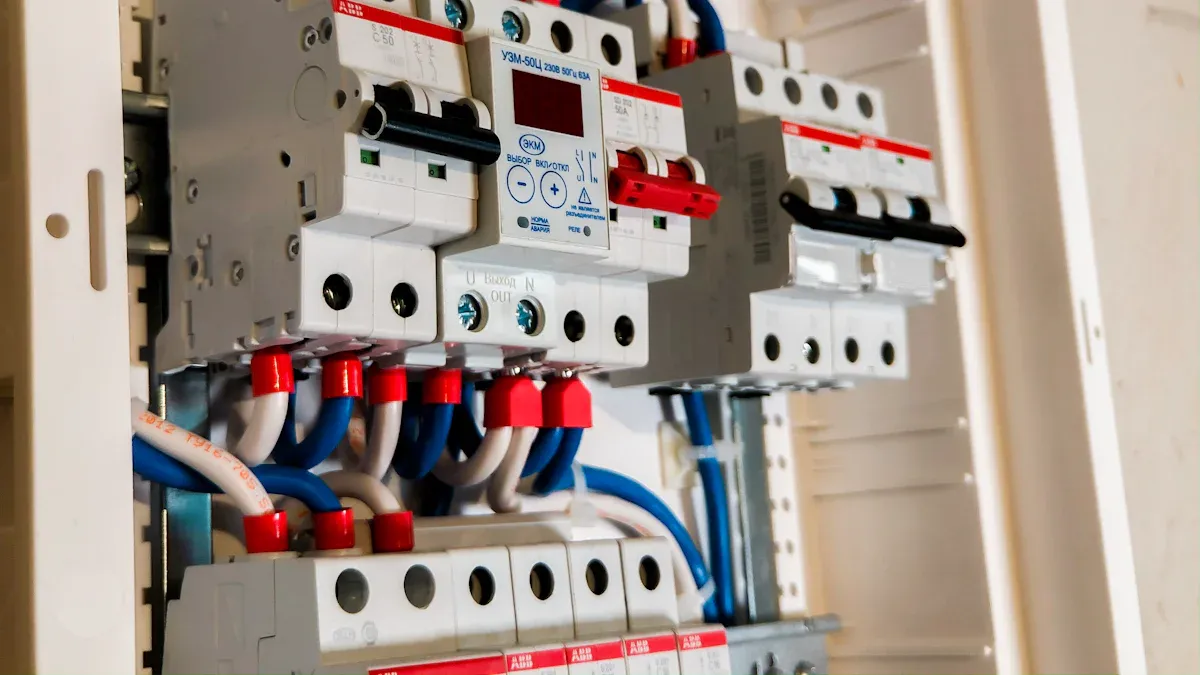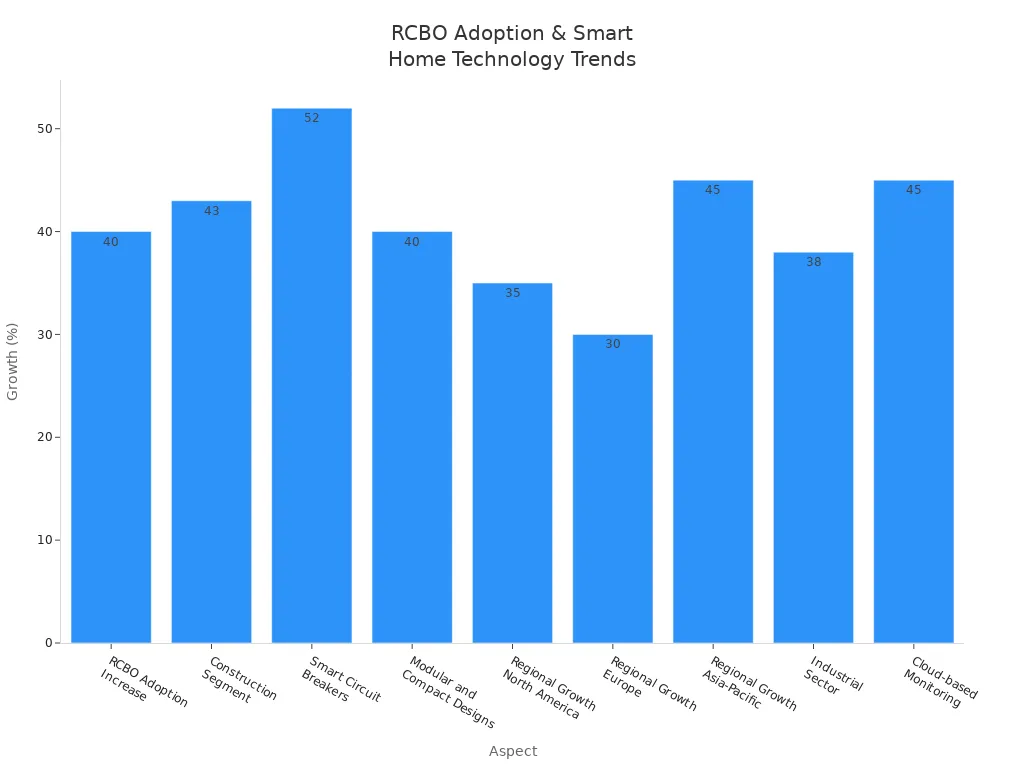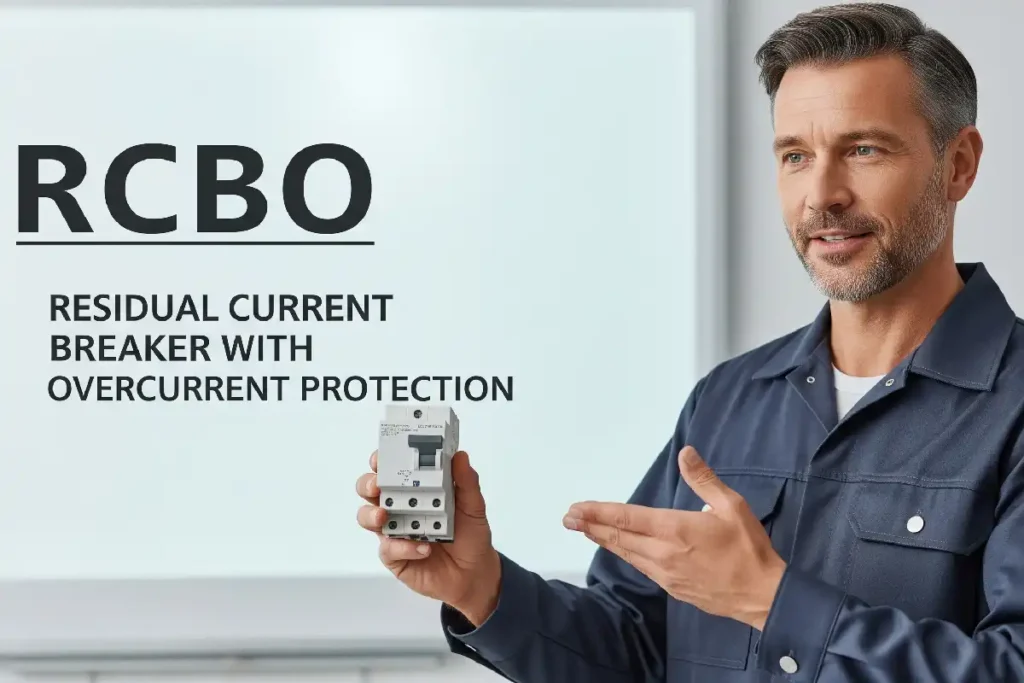The rcbo electrical full name is Residual Current Circuit Breaker with Overcurrent Protection. This device can find two kinds of electrical problems: earth leakage and overcurrent. You get two kinds of safety because an rcbo watches the current flow. It will trip if it finds a problem, like a short circuit or if someone touches a live wire. Knowing the rcbo electrical full name helps you see how the rcbo full form in electrical systems keeps you safe. If you learn about rcbo types and how to use them, you can pick the right device for your home or equipment. This lowers the chance of electric shocks and fires.
Key Takeaways
- RCBO means Residual Current Circuit Breaker with Overcurrent Protection. It gives two types of protection in one device. It finds earth leakage and overcurrent. This helps stop electric shocks and fires fast. RCBOs protect each circuit by itself. Only the bad circuit turns off, so others keep working. Using RCBOs saves space. It also makes electrical systems safer and easier to use. RCBOs are great for homes and offices. They are also good for places with more shock risk like kitchens and bathrooms.
RCBO Electrical Full Name
RCBO Full Form in Electrical
You might see RCBO on many electrical panels. The rcbo electrical full name is Residual Current Circuit Breaker with Overcurrent Protection. International rules, like IEC 61009, use this name. Sometimes, people call it a residual current breaker or a residual current circuit breaker with overload protection. All these names mean the same device.
Tip: When you check your panel, look for RCBO or residual current breaker. Both names show the device protects you from two dangers.
Here is what each part of the rcbo full form in electrical means:
- Residual Current: This means the device can find small leaks of electricity. If electricity escapes and goes to the ground, the RCBO will notice. This is called earth leakage. The device has a sensor to watch for this.
- Circuit Breaker: This part stops electricity if something is wrong. If the RCBO finds a problem, it will trip and turn off the power.
- Overcurrent Protection: This means the RCBO can tell when too much electricity flows. Overcurrent can happen if you plug in too many things or if wires touch. The RCBO will trip to stop overheating and fires.
You get two kinds of protection in one device. The RCBO does the job of a residual current device and a miniature circuit breaker. It checks for earth leakage and overcurrent at the same time. If it finds a problem, it will trip and keep you safe.
Residual Current Circuit Breaker Meaning
The name residual current circuit breaker means a device that watches electricity in your wires. It looks for changes between the current going out and coming back. If the RCBO finds a change, it means electricity is leaking, maybe through a person or into the ground. The device will trip fast, often in milliseconds, to stop electric shocks.
RCBOs also protect against too much current and short circuits. If you use too many devices or wires touch, the RCBO will sense extra current. It will trip to stop damage or fire. This makes the RCBO a good choice for homes, schools, and offices.
Note: RCBOs follow strict rules from international standards. IEC 61008 and IEC 61009 make sure these breakers work safely. You do not need special training to use them. You can trust RCBOs to protect your circuits every day.
Here is a simple table to help you see the difference between RCBO and other breakers:
| Device Name | Protects Against Earth Leakage | Protects Against Overcurrent | Typical Use |
|---|---|---|---|
| RCBO | ✅ | ✅ | Individual circuits |
| Residual Current Device | ✅ | ❌ | Main protection |
| Miniature Circuit Breaker | ❌ | ✅ | Overload/short |
You can see the rcbo electrical full name shows its double protection. When you pick an RCBO, you get a residual current breaker and an overcurrent protector in one. This helps keep your home and family safe.
How RCBO Works
Dual Protection Function
You might ask why an RCBO is special. An RCBO has the features of both an RCD and an MCB. This gives you two kinds of protection in one device. The RCBO protects against residual current and overcurrent.
Here is how this dual protection works in real circuits:
- The RCBO watches the current in both live and neutral wires.
- It checks if the current going out matches the current coming back. If there is a difference, some current is leaking. This can happen through a person or broken insulation.
- The RCBO trips right away if it finds leakage. It shuts off power to stop electric shock.
- The RCBO also looks for too much current. If you plug in many devices or a short circuit happens, it senses extra current.
- The RCBO trips to stop overheating, fire, or damage.
Tip: Using an RCBO gives you both leakage and overcurrent protection for each circuit. You do not need separate RCD and MCB devices.
Inside the RCBO, there are two sensors. One sensor checks for too much current. The other sensor looks for residual current. If either sensor finds a problem, the RCBO quickly disconnects the circuit. This keeps your home or office safe from shocks and fires.
Residual Current Circuit Breaker with Overload Protection
A residual current circuit breaker with overload protection watches for two dangers: earth leakage and too much current. The RCBO uses smart electronics to find even small leaks. If a wire gets cut or insulation breaks, the RCBO sees the difference between live and neutral wires. This is how it gives residual current protection.
RCBOs also work like miniature circuit breakers. They trip when the current is too high. This keeps your wires and devices safe from heat or fire. The RCBO acts very fast. For earth leakage, most RCBOs trip in less than 150 milliseconds. For overcurrent, they trip in about 100 milliseconds. You can see these times in the table below:
| Event Type | Typical Response Time (ms) | Notes |
|---|---|---|
| Earth Leakage | 50 – 69 | 30mA RCBO trips in 69ms. Most trip under 150ms. |
| Overcurrent | ~100 | Type C 20A RCBO trips in about 100ms. |
| Coordination | Variable | Upstream devices may delay to let RCBO trip first. |
RCBOs protect each circuit by itself. If something goes wrong, only that circuit turns off. Other circuits keep working. This saves time and keeps your home running well.
Here is how RCBOs are different from other devices:
- RCBOs do what an RCD and an MCB do together. They protect you from electric shock, earth faults, overloads, and short circuits.
- RCDs only protect against earth faults and shocks. They do not stop overloads or short circuits.
- MCBs only protect against overloads and short circuits. They do not stop leakage.
RCBOs use built-in sensors and electronics to find both problems. When you install a residual current circuit breaker with overload protection, your electrical system becomes safer. That is why many new homes and offices use RCBOs for each circuit.
Note: RCBOs help stop electric shock accidents and fire risks. They also make your electrical system smaller and easier to use. You can protect each circuit directly, which is safer and better.
RCBOs work as a residual current breaker with overcurrent protection. You do not need separate devices for each fault. The RCBO does everything, making your electrical system safer and easier to manage.
RCBO vs RCD, RCCB, MCB

Key Differences
There are different types of circuit breakers. The most common ones are RCBO, RCD, RCCB, and MCB. Each one does a special job in your electrical system. It is important to know how they are not the same. This helps you pick the best one for your needs.
Here is a table that shows how they are different:
| Feature | RCD/RCCB/RCB | MCB | RCBO |
|---|---|---|---|
| Protection Type | Earth leakage protection only | Overcurrent and short circuit only | Combination of earth leakage and overcurrent/short circuit protection |
| Trip Mechanism | Detects leakage current | Thermal and magnetic trip | Residual current sensing plus thermal/magnetic trip |
| Circuit Coverage | Can cover multiple circuits | Individual circuit protection only | Individual circuit protection only, trips only faulty circuit |
| Safety Focus | Prevents electric shocks | Protects appliances and wiring | Provides comprehensive protection for both user safety and equipment |
| Installation | Usually installed before MCBs | Installed per circuit | Combines RCD and MCB functions, saving space |
| Cost and Efficiency | Lower cost, less comprehensive | Moderate cost, limited to overcurrent | Higher cost, more efficient and comprehensive |
An rcbo gives you two kinds of protection in one device. An rcd or rccb only stops electric shocks. An mcb only protects from too much current or short circuits. The rcbo does both jobs. This makes it a very safe choice.
When to Use RCBO
You should use an rcbo if you want the best safety for each circuit. RCBOs work great in homes, offices, and places with important equipment like computers. If you use just an rcd or rccb, one problem can turn off all your circuits. With an rcbo, only the broken circuit turns off. The rest of your home keeps working.
RCBOs also save space because they do two jobs in one device. They may cost more at first, but they make wiring easier and help find problems faster. Over time, rcbo devices can lower repair needs. They also make fixing problems simpler. Some brands work better than others, so look for good quality and trusted names when picking an rcbo.
If you want to keep your family, your things, and your wires safe, rcbo circuit breakers are a smart pick. They give you the best safety for modern electrical systems.
RCBO Applications and Importance
Safety Benefits
You need good protection to keep people and things safe. RCBOs are important in modern systems. They have both earth leakage and overcurrent features. This means you get two protections in one small device. If something goes wrong, the RCBO shuts off power fast. This helps stop electric shocks and fires.
RCBOs protect each circuit on their own. If there is a problem, only that circuit turns off. The rest of your house or building keeps working. This makes it easy to find and fix problems. You can test the RCBO with a button to check if it works. The small size makes it easy to put in most panels. This saves space and time. RCBOs are great for places with water, like kitchens and bathrooms. These places have a higher risk of shock.
Tip: RCBOs help you follow safety rules in many places. Some laws say you must use them in risky areas. This keeps you safe and legal.
Typical Uses
You can find RCBOs in many electrical systems. They are used in homes, offices, factories, and public buildings. You can use them to protect circuits for special devices, air conditioners, water heaters, and solar systems. RCBOs are also used in data centers, elevators, and big machines.
RCBOs work as both earth leakage and overload protectors. This makes them good for circuits with shock and fire risks. You can use RCBOs where you need to stop faults fast, like in hospitals or schools. They are easy to install and reset, so they are simple to use.
Here is a table that compares RCBOs and GFCI breakers:
| Feature | RCBO | GFCI Breaker |
|---|---|---|
| Protection Type | Earth leakage and overcurrent | Ground fault only |
| Typical Application | Full circuit protection in many environments | Wet or high-risk areas |
| Installation Location | Breaker panels | Outlets or breaker panels |
| Cost | Higher, but saves space | Lower, needs extra breakers |
RCBOs give you strong protection and help keep your electrical system safe and working well.
You have learned that RCBO means Residual Current Circuit Breaker with Overcurrent Protection. This device gives you two kinds of safety in one. It protects you from electric shocks and fires. The RCBO can find earth leakage and overcurrent problems.
- RCBOs mix the good parts of RCDs and circuit breakers. This makes your electrical system safer and easier to take care of.
- You can put them in homes, offices, or factories. They give strong protection and make upgrades simple.

Picking RCBOs helps you follow safety rules. It also gets your system ready for new changes in the future.
FAQ
What does RCBO stand for in electrical systems?
RCBO stands for Residual Current Circuit Breaker with Overcurrent Protection. You use it to protect circuits from earth leakage and too much current.
What makes RCBO different from other circuit breakers?
You get two protections in one device. RCBO protects you from electric shocks and also stops overloads or short circuits. Other breakers only do one job.
What are the main benefits of using RCBOs?
You increase safety in your home or office. RCBOs trip fast to prevent electric shocks and fires. You can protect each circuit separately.
What should you look for when choosing an RCBO?
You should check the rating and type. You can also compare top rcbo brands for quality and reliability. Pick one that fits your panel and meets safety standards.
What is the best way to test if your RCBO works?
You press the test button on the RCBO. If it trips, the device works. You should test it every month to keep your system safe.
See also
RCBO residual current circuit breaker with overcurrent protection
Understanding RCBO Breaker Terminology Made Simple
RCBO and RCCB Explained for Beginners
How to Safely Connect RCBOs in Your Electrical Distribution Panel
What Features Make an RCBO Essential for Modern EV Charger Setups



